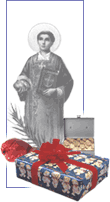December 31: Feast Day of Pope Silvester I
 When I first lived in Switzerland, way back in the winter of 1986, a certain Ms. D'aujourd'hui . . .
When I first lived in Switzerland, way back in the winter of 1986, a certain Ms. D'aujourd'hui . . .Yes, I realize that this sounds like the beginning of a dirty joke or an off-color escapade with some disreputable "lady of the night" . . . or "of the day" . . . but worry not. Ms. D'aujourd'hui really existed and was never involved with me in any untoward 'story.'
Indeed, she still exists, and if you Google her name, "Simone D'aujourd'hui," you discover that as recently as 2004, she was wishing someone a Merry Christmas and a Happy New Year:
19.12.2004 19:56: Simone D'aujourd'hui, SchaffhuuseYes, that's a Swiss-German dialect -- except for the "turnsaison" Franglais. Note that she is quite aware of the strangeness of her "komische nochname."
sali zämä, ich wünsche eu allne au gaanz schöni wiähnachte und en guete rutsch is 2005. shät üs gfalle bi eu und ich hoff dass me sich nögscht turnsaison mol irgendwo atrifft... liäbi grüäss vo dere us schaffhuuse mit em komische nochname!
Despite her unusual French name, Ms. D'aujourd'hui was a very Swiss-German young lady from the vicinity of Zurich, and since I was living with her Italian boyfriend in the university town of Fribourg, she happened to ask me what I would be doing on "Silvester."
I'd never heard of this holiday, and when I asked for an explanation, I learned two things.
First, it meant the same as New Year's Eve.
Second, it 'honored' the memory of the Pope Silvester who had held the Holy Office in the year 999, for he had expected the world to end at the onset of the millenium year 1000 A.D.
It didn't end, so everybody celebrated.
Thus today's New Year's celebrations.
Well, Ms. D'aujourd'hui had the first point correct, but as for the second point, I've had to un-learn that bit of crosscultural understanding.
The New Year's Eve Silvester celebration honors not the fascinating Pope Silvester II (999 - May 12, 2003) but the famously obscure Pope Silvester I (January 314 - December 31, 335), whose papacy is remembered for "little else than a record of the gifts said to have been conferred on the Roman Church by Constantine the Great."
Pope Silvester I is especially famous among historians for a very special 'gift' from Constantine that he didn't really receive: The Donation of Constantine.
According to this later, Medieval forgery, Constantine the Great granted Pope Sylvester I and his successors dominion over the entire Western Roman Empire. Medieval popes used this forged document in their attempts to assert secular authority over political leaders in Western Europe. The Italian Renaissance humanist Lorenzo Valla put a stop to that in 1440 when he proved the Donation a forgery by showing that some of the document's Latin had to have been written later than the fourth century.
According to a rather outrageous legend, the Donation was a gift of gratitude from Constantine because Pope Silvester I had cured him of leprosy by baptizing him in a bath of blood -- from which, we do NOT get the word "bloodbath."
But speaking of bloodbaths, Wikipedia adds the following disturbing bit of information:
According to Jewish tradition, January 1st, the day of the secular new year is known in Hebrew as Sylvester [Day] . . . named for Silvester I, who convinced the emperor Constantine to prohibit Jews from living in Jerusalem, and who arranged for the passage of anti-Semitic laws more than 1,700 years ago.I don't know if this Jewish tradition about Silvester's role in barring Jews from Jerusalem or in passing anti-Semitic laws is historically accurate, but just in case it should prove accurate and thus implicate Silvester in the later bloodbaths to which Jews were subjected, let's raise our cups this New Year's Eve not specifically to Pope Silvester but to the New Year itself.







